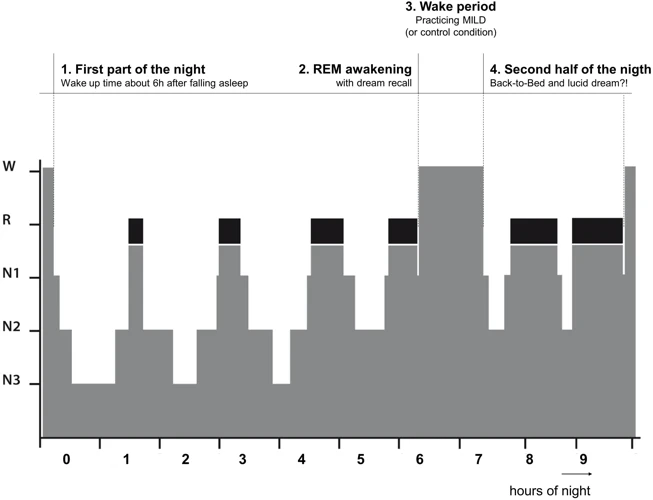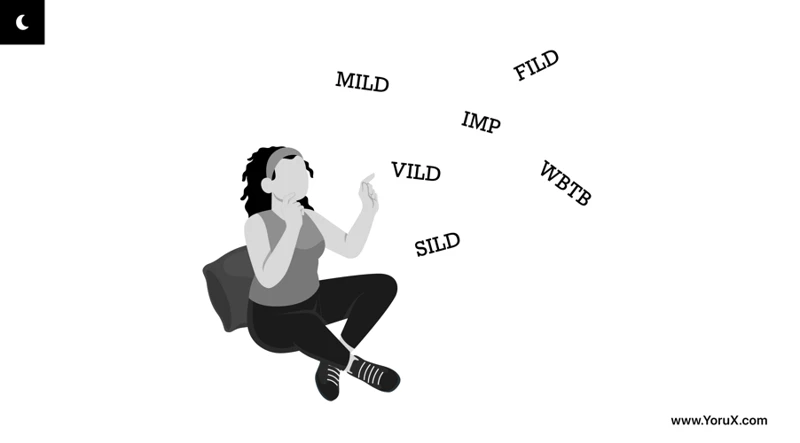Contents
- Introduction
- Step 1: Recall Your Dreams
- Step 2: Set Your Intention
- Step 3: Focus on Your Reality
- Step 4: Visualize Your Dream
- Step 5: Enter Your Dream State
- Conclusion
-
Frequently Asked Questions
- What if I don’t remember my dreams?
- How long does it take to see results with MILD?
- Can MILD be combined with other lucid dreaming techniques?
- What should I do if I become lucid in a dream?
- Is it possible to have a lucid nightmare with MILD?
- Can MILD be practiced by everyone?
- How many reality checks should I perform during the day?
- What are some common reality checks used with MILD?
- What if I try MILD but it doesn’t work for me?
- Is lucid dreaming a safe practice?
- References
Introduction

Embarking on the journey of lucid dreaming can be a daunting task for many, but with the right techniques and practice, anyone can achieve this incredible phenomenon. One of the most effective methods for inducing lucid dreams is through the Mnemonic Induction of Lucid Dreams (MILD) technique. By combining elements of reality checks, dream journaling, intention setting, and visualization, MILD offers a comprehensive approach to increasing the likelihood of achieving lucidity during dreaming. In this article, we’ll explore the 5 steps to successfully practice MILD for lucid dreaming, and equip you with the tools and knowledge to enter the world of lucid dreaming with confidence. So, let’s dive in!
What is MILD?
Mnemonic Induction of Lucid Dreams (MILD) is a technique that was developed by Dr. Stephen LaBerge in the 1980s. This technique is aimed at helping individuals consciously control their dreams and achieve a lucid state while they are still dreaming. MILD is designed to be used during the REM (Rapid Eye Movement) stage of sleep, which is the stage where most of our dreaming occurs.
MILD involves setting intentions before sleep to remember that you are dreaming and to become lucid in the dream. According to Dr. LaBerge, the best time to start practicing MILD is after you have woken up from a dream and are still in a semi-conscious state. During this time, you should recall the dream you had just experienced and affirm to yourself that you will become aware that you are dreaming the next time you have a dream.
The core principle of MILD is to use mnemonic devices, such as affirmations and visualizations, to increase the chances of becoming aware and in control during the dream state. By repeating affirmations to yourself before bed and visualizing yourself becoming aware that you are dreaming, this technique aims to make lucidity in dreams a natural occurrence.
One of the major benefits of MILD is that it is accessible to anyone, regardless of their prior experience with lucid dreaming. MILD has been shown to be effective for inducing lucid dreams in both novice and experienced dreamers. It is a relatively easy and straightforward technique that can be performed without any external tools or equipment.
MILD is a powerful tool for those who want to take control of their dreams and have a more conscious experience during their sleep. With practice, anyone can learn to successfully use this technique to achieve lucid dreaming states.
| What is MILD? | Mnemonic Induction of Lucid Dreams technique developed by Dr. Stephen LaBerge. |
| Objective | To consciously control dreams and achieve a lucid state during REM. |
| Core Principle | Use of mnemonic devices, such as affirmations and visualizations, to increase chances of becoming aware and in control during the dream state. |
| Benefits | Effective for inducing lucid dreams in both novice and experienced dreamers. Relatively easy and straightforward without any external tools or equipment. |
Why Practice MILD?
One of the primary reasons to practice Mnemonic Induction of Lucid Dreams (MILD) is to gain control over your dreams by inducing lucid dreaming, which is the conscious awareness of oneself during a dream. Lucid dreaming can be a thrilling and enlightening experience that can lead to a deeper understanding of your subconscious mind. Here are some other reasons to practice MILD:
| Reasons to Practice MILD |
|---|
| Improve your deep sleep |
| Overcome nightmares and recurring bad dreams |
| Increase creativity and problem-solving abilities |
| Reduce anxiety and stress |
| Enhance spiritual growth and self-awareness |
By practicing MILD, you can train your brain to become more aware of your dreams and eventually, you may even be able to control the events of your dreams. This can lead to a greater sense of self-confidence and an improved outlook on life. Additionally, MILD can help you overcome nightmares and recurring bad dreams by giving you the tools to become aware that you are dreaming and take control of your dream environment.
Practicing MILD can enhance your creativity and problem-solving abilities by tapping into your subconscious mind. By becoming more in tune with your dreams, you may be able to identify patterns or symbols that relate to your waking life and learn to use this knowledge to solve real-world problems.
MILD can also reduce anxiety and stress by allowing you to confront and process any unresolved emotional issues that may surface in your dreams. Lastly, MILD can promote spiritual growth and self-awareness by providing a deeper understanding of your inner thoughts and feelings.
What to Expect
As you begin to practice MILD for lucid dreaming, here are some things to keep in mind:
1. Results May Take Time: Don’t be discouraged if you don’t have a lucid dream right away. It can take time and consistent practice to see results. Be patient and persistent.
2. Your Dream Recollection May Improve: As you begin to focus more on your dreams and keep a dream journal, you may notice that you remember more of your dreams in greater detail.
3. Reality Checks Can Become Second Nature: With practice, reality checks can become so ingrained in your routine that you naturally start to question whether you’re awake or dreaming.
4. You May Experience False Awakenings: False awakenings happen when you dream that you’ve woken up, but you’re still in a dream. This can be frustrating, but it’s also an opportunity to practice reality checks.
5. Lucid Dreams Can Be Unpredictable: In lucid dreams, anything is possible. You may find yourself in strange or unexpected situations, and your dream may not always follow a logical progression.
6. The Rewards Are Worth It: Lucid dreaming can be an incredibly rewarding experience. When you learn to control your dreams, you can explore new worlds, face your fears, and even find solutions to real-life problems. Keep this in mind as you work towards your lucid dreaming goals.
Step 1: Recall Your Dreams

One of the essential steps in practicing MILD for lucid dreaming is building your dream recall abilities. Through recalling your dreams, you become aware of what happens during your sleep and gain the ability to recognize when you are in a dream state. It can be perplexing to know where to start, but with dedication and practice, anyone can improve their dream recall abilities. In this section, we will explore effective techniques to recall your dreams and increase your chances of becoming lucid during sleep.
Keeping a Dream Journal
Keeping a dream journal is a crucial aspect of practicing MILD. It helps to improve dream recall and identify recurring dream themes, which can be used later in visualizing your dreams. Here are some tips for maintaining an effective dream journal:
| Tip | Description |
| Keep It Nearby | Keep your dream journal within reach of your bed so you can write down any dreams you remember immediately upon waking up. |
| Write in Detail | Write down as much detail about your dreams as possible, including any emotions or sensations you experienced. |
| Date Each Entry | Make sure to date each entry, so you can track your progress in dream recall. |
| Use Keywords | Use keywords to identify recurring themes in your dreams, which can be used later in visualization techniques. |
| Revisit Your Entries | Revisit your dream journal entries periodically to identify any patterns or themes that emerge over time. |
By following these tips, you can create an effective dream journal that can improve your dream recall and provide valuable insight into your subconscious mind.
Other Tips for Dream Recall
One of the most important steps in practicing MILD for lucid dreaming is being able to recall your dreams. Here are some tips that can help with dream recall:
- Get enough sleep: This may seem obvious, but it’s much easier to remember your dreams if you’re well-rested. Aim for seven to nine hours of sleep each night.
- Wake up without an alarm: Try to wake up naturally without an alarm if possible. This can help you remember your dreams more clearly.
- Stay still upon waking: When you first wake up, try to stay still and focus on any dream fragments or details that come to mind. Don’t start moving around or checking your phone right away.
- Write down your dreams: Keeping a dream journal is a great way to improve dream recall. Write down as much detail as you can remember about your dreams, including any emotions, colors, and sensations you experienced.
- Use keywords: If you don’t have time to write down a full dream, try to jot down a few keywords or phrases that will help you remember it later.
- Review your dreams: Take some time each day to review your dream journal and reflect on any patterns or recurring themes that you notice. This can help you recognize when you’re dreaming and trigger a lucid dream.
- Practice visualization: Before going to sleep, visualize yourself remembering your dreams and having a successful lucid dream. The more you practice, the easier it will become.
- Avoid sleep aids: Sleep aids such as alcohol, sleeping pills, and certain medications can interfere with dream recall. Try to avoid them if possible, or talk to your doctor if they’re necessary for your health.
By following these tips, you’ll be able to improve your dream recall and increase your chances of having a lucid dream through MILD.
Step 2: Set Your Intention

As you progress towards your lucid dream goals, it’s important to set a clear intention before you go to bed. This step is all about motivating yourself to take control of your dreams and actively participate in them. By setting a clear intention and using powerful affirmations, you can tell your subconscious mind that you’re ready to become aware and in control of your dreams. In this section, we will explore the best ways to set your intention for your lucid dreams and stay motivated throughout the process.
Motivate Yourself
Motivation is a critical component of successfully practicing MILD for lucid dreaming. Without adequately motivating yourself, it can be challenging to keep up with the practice long enough to see any results. Here are some strategies to help you stay motivated on your journey:
- Set achievable goals: One way to stay motivated is to set achievable goals for yourself. Instead of aiming to become a master lucid dreamer overnight, set smaller, achievable goals for yourself, such as recalling your dreams more often or having one lucid dream a week.
- Track your progress: Keeping track of your progress can also help to motivate you. Use a dream journal or tracking app to document your successes and setbacks, and review them regularly to see how far you’ve come.
- Join a community: Connecting with others who share your interest in lucid dreaming can also be motivating. Join an online forum or community where you can find support and inspiration from others on the same journey.
- Visualize your success: Another way to stay motivated is to visualize yourself achieving your goals. Take a moment each day to imagine yourself having a lucid dream, and how it will feel when you do.
- Celebrate your successes: Finally, be sure to celebrate your successes along the way. Rewar yourself for achieving your goals, even if they are small. These rewards can serve as motivation for sticking with the practice in the long run.
By incorporating these strategies into your MILD practice, you can help yourself stay motivated and committed to achieving lucid dreaming success.
The Power of Affirmations
Affirmations are a powerful tool that can help you achieve your goals and desires. Specifically, when it comes to lucid dreaming, affirmations can help you set your intention and focus your mind on achieving lucidity in your dreams. Here are some tips for creating and using affirmations in your MILD practice:
- Be specific: When creating your affirmations, be specific about what you want to achieve. For example, instead of saying “I will have a lucid dream tonight,” say “I will recognize that I am dreaming while I am dreaming tonight.”
- Use present tense: Phrase your affirmations in the present tense, as if you have already achieved your goal. For example, “I am aware that I am dreaming” rather than “I will become aware that I am dreaming.”
- Use positive language: Use positive, empowering language in your affirmations. Instead of saying “I am not afraid of nightmares,” say “I am fearless in my dreams.”
- Repeat them often: Repeat your affirmations to yourself throughout the day and before bed. This will help embed them into your subconscious mind and make them more effective.
- Visualize as you say them: As you repeat your affirmations, visualize yourself achieving your goal. See yourself recognizing that you are dreaming and taking control of your dream.
By using affirmations in your MILD practice, you can set your intention and focus your mind on achieving lucidity in your dreams. The more you use affirmations, and the more you believe in their power, the more effective they will be in helping you achieve your lucid dreaming goals.
Step 3: Focus on Your Reality

As you delve deeper into the MILD technique, it’s important to focus on your reality in order to increase your chances of having a lucid dream. This step involves regularly performing reality checks and being mindful of your surroundings throughout the day. By incorporating these techniques into your daily routine, you’ll train your mind to recognize when you’re in a dream state, ultimately leading to more frequent lucid dreams. So, let’s take a closer look at how to make this a habit and increase your chances of success.
Perform Reality Checks
Performing reality checks regularly is an essential step in the MILD technique for lucid dreaming. Reality checks help you determine whether you are in a dream or in waking reality. This step requires conscious effort and mindfulness to become a habit.
Here are some reality checks you can perform during your waking hours:
| Reality Check | Description |
|---|---|
| Nose Pinch Test | Try to breathe through your nose while pinching it shut. If you can still breathe, you are likely in a dream state. |
| Finger Through the Palm | Try to push one finger of your hand through the palm of your other hand. If it goes through, you are likely in a dream state. |
| Reading Test | Look at text or a digital clock. Look away and then look back at the text or the clock. If the text or the numbers have changed or are jumbled, you are likely in a dream state. |
| Light Switch Test | Try to turn on and off the light switch in a room or flip a light switch. If the light does not change or if the switch feels weird, you are likely in a dream state. |
It’s essential to choose one or two reality checks and perform them habitually to increase the chance of using them in a dream. Remember to ask yourself if you are dreaming and perform a reality check whenever you notice something out of the ordinary, such as an odd sensation or an abnormal shadow.
Make Reality Checks a Habit
One crucial step in MILD for lucid dreaming is to make reality checks a habit. This means regularly checking if you’re dreaming throughout the day. Making this a habit can help train your brain to become more aware of the differences between being awake and being in a dream state.
To make reality checks a habit, try incorporating them into your daily routine. In addition to performing reality checks whenever something seems unusual, set reminders on your phone or computer to do them at specific intervals throughout the day. This will help keep the idea of reality checks at the front of your mind.
It’s important to use a variety of reality checks, such as checking the time, counting your fingers, or trying to push your hand through a solid object. By incorporating different reality checks, you’ll be more likely to recognize when you’re in a dream state.
Another helpful tip is to constantly question your reality. Ask yourself throughout the day if what you’re experiencing could be a dream. This will help you become more aware of your surroundings and help you identify when you’re in a dream state.
Finally, be consistent with your reality checks. Making this a habit requires effort and consistency, but the payoff can be significant. With practice, you may find yourself naturally performing reality checks in your dreams, leading to an increased likelihood of achieving lucid dreams.
Step 4: Visualize Your Dream

Now that you have set your intention and focused on your reality, it is time to take the next step in MILD: visualizing your dream. Visualizing your dream before you fall asleep is a powerful technique that can help you recognize when you are in a dream and become lucid. By using your imagination to create a detailed image of yourself in a dream and affirming that image, you can increase your chances of having a lucid dream. Let’s explore some effective visualization techniques that can help you achieve your dream state.
Affirm Your Dream Self
One important step in visualizing your dream is to affirm your dream self. This means you should imagine yourself as a lucid dreamer and confidently affirm your ability to control your dreams. Here are some tips for affirming your dream self:
- Choose a positive affirmation: Select a short, positive statement that reflects your desire to become a skilled lucid dreamer. For example, you could say, “I am a natural lucid dreamer” or “I control my dreams with ease.”
- Repeat your affirmation: Once you have chosen your positive statement, repeat it to yourself several times throughout the day. This will help to reinforce your intention and build your confidence as a lucid dreamer.
- Believe in yourself: It’s important to believe that you have the power to control your dreams. If you approach lucid dreaming with doubt or skepticism, it will be harder to achieve success. Instead, embrace a positive attitude and trust in your ability to become a skilled lucid dreamer.
- Visualize your success: Along with your positive affirmation, visualize yourself as a skilled lucid dreamer. Imagine yourself flying through the sky, exploring new worlds, and experiencing incredible adventures. This visualization will help to deepen your belief in your ability to control your dreams.
Affirming your dream self is a crucial aspect of MILD practice. By building your confidence and visualizing success, you will be better equipped to enter a lucid dream state and achieve your dream goals.
Practice Visualization Techniques
Visualization is an important aspect of the MILD technique as it helps to create a mental image of the desired outcome, which is to become lucid in a dream. There are several visualization techniques that can be practiced to help with this process.
One effective technique is to use mental imagery to visualize yourself becoming lucid in a dream. Close your eyes and imagine yourself in a dream, becoming aware that you are dreaming. See yourself looking around and taking control of the dream. Use as much detail as possible, imagining the sensations and emotions of the dream state.
Another technique is to use visual cues to trigger lucidity in a dream. Choose a specific object or image that is easy to remember and visualize it before going to bed. This could be a symbol, a landscape, or even a person. The idea is to associate this image with becoming lucid in a dream. When you see the image in your dream, it should remind you to become aware that you are dreaming.
It can be helpful to use a combination of these visualization techniques. For example, you could practice visualizing yourself becoming lucid in a dream while also visualizing a specific image that will trigger the realization that you are dreaming.
| Benefits of Visualization Techniques: | Challenges Of Visualization Techniques: |
|---|---|
|
|
Practice these visualization techniques regularly, and don’t be discouraged if it takes time to see results. Each person’s experience with MILD will be unique, and there may be trial and error involved in finding the techniques that work best for you.
Step 5: Enter Your Dream State
Now that you have completed the preparation steps for MILD, it’s time to enter your dream state. This can be tricky, as you want to maintain a level of relaxation while also keeping your mind focused on your intention to have a lucid dream. In this step, we’ll cover the mnemonic induction technique, which can help you achieve the right balance to successfully enter your dream state. We’ll also discuss other techniques that you can use if the Mnemonic Induction Technique does not work for you. By the end of this step, you should be ready to experience a lucid dream.
The Mnemonic Induction Technique
The Mnemonic Induction Technique, commonly referred to as MILD, is a technique that involves using verbal or mental cues to help the dreamer remember that they are dreaming. The intention is to carry the memory of the intention to have a lucid dream into the dream itself. Here are the steps for practicing MILD effectively:
- Wake Up During REM Sleep: Set an alarm to wake up during one of your REM sleep cycles. This is the stage of sleep where dreaming occurs and is the best time to practice MILD.
- Create an Affirmation: Choose a simple phrase that focuses on the intention to have a lucid dream. For example, “Tonight, I will realize I’m dreaming.” Repeat this phrase to yourself as you fall back asleep. Visualize yourself becoming lucid in your dream as you say it.
- Picture Yourself Becoming Lucid: Imagine yourself finding a dream sign or performing a reality check in your dream. This will help to create a strong association in your mind between the affirmation and the experience of becoming lucid in a dream.
- Practice Consistently: It’s important to practice MILD consistently, every night if possible. Even if you don’t become lucid immediately, the repetition of the affirmation and visualization will eventually manifest in a lucid dream.
Remember, the goal of MILD is to create a mental habit that will carry over into your dreams. By waking up during REM sleep cycles, creating a clear and concise affirmation, visualizing yourself becoming lucid, and practicing consistently, you can successfully practice the Mnemonic Induction Technique for lucid dreaming.
Other Ways to Enter a Dream State
There are various ways to enter a dream state besides the Mnemonic Induction Technique (MILD). Here are some other methods that you can try:
- The Wake-Back-to-Bed (WBTB) Technique: This technique involves waking up after about five hours of sleep, staying awake for a short time (10-30 minutes), and then going back to sleep with the intention of having a lucid dream. This technique works well because it allows you to go directly into Rapid Eye Movement (REM) sleep, the stage of sleep where most dreaming occurs.
- The Cycle Adjustment Technique: This technique involves adjusting your sleep cycle so that you wake up during a REM period. To do this, you need to figure out how long each of your sleep cycles lasts (which is typically around 90 minutes), and then set your alarm to wake you up during a REM period. Once you wake up, go back to sleep and focus on having a lucid dream.
- The Dream Exit-Initiated Lucid Dream (DEILD) Technique: This technique involves waking up naturally from a dream, and then immediately going back to sleep with the intention of re-entering the same dream, but this time with the awareness that you are dreaming. To do this technique, practice becoming more aware during your dreams and cultivating the ability to recognize when you are dreaming.
- The Visualize-Induce-Lucid-Dream (VILD) Technique: This technique involves visualizing a dream scenario in your mind and then entering that scenario consciously. For example, you could imagine yourself walking on a beach, feeling the sand between your toes, and hearing the sound of the waves crashing. By repeatedly visualizing this dream scenario, you may eventually find yourself in a lucid dream that matches your visualization.
- The Wake-Initiated Lucid Dream (WILD) Technique: This technique involves staying awake while your body falls asleep. To do this, you need to lie down in a comfortable position, relax your body, and focus on your breath. As you start to fall asleep, try to maintain your awareness, and focus on entering a dream state consciously. This technique can be more challenging than others, but some people find it very effective.
Keep in mind that not every technique will work for everyone, so it’s important to experiment and find what works best for you. Additionally, remember that practicing MILD and other lucid dreaming techniques consistently and with dedication will give you a better chance of success.
Conclusion
As we reach the end of this journey towards practicing MILD for lucid dreaming, one may feel a mix of excitement and hesitance. It’s understandable as the prospect of being able to control your dreams is both fascinating and daunting. However, with determination and persistence, anyone can achieve success with MILD. In this final section, we’ll go over some tips for sticking with MILD, some additional techniques to enhance your lucid dreams, and some final thoughts on the practice. So put on your dreaming hat and let’s dive in.
How to Stick with MILD
One of the keys to success when practicing MILD for lucid dreaming is to stick with it consistently. Here are a few tips to help you do just that:
| Tip | Description |
| Set a schedule | Try to practice MILD at the same time every day. Consistency is key! |
| Find a partner | Having someone to practice with can help motivate you and keep you on track. |
| Keep a dream journal | This can help you stay focused on your goals and keep the motivation going. |
| Remind yourself | Use reminders throughout the day to keep MILD at the forefront of your mind. |
| Stay patient | Remember that lucid dreaming takes time and practice, so be patient with yourself. |
By implementing these tips, you can help yourself stay consistent with MILD and increase your chances of experiencing a lucid dream. Remember to be persistent and to always keep your goals in mind!
Other Tips and Tricks
Here are some additional tips and tricks to help enhance your MILD practice:
- Use Aromatherapy: Incorporating essential oils, such as lavender or peppermint, into your routine may help improve sleep quality and increase the chances of lucid dreaming.
- Establish a Bedtime Routine: Going to bed and waking up at the same time every day can help regulate your sleep patterns and make it easier to remember your dreams.
- Try Subliminal Messaging: Listening to subliminal messages while falling asleep can help set the intention for lucid dreaming and increase the chances of success.
- Experiment with Sleep Positions: Some lucid dreamers believe that sleeping in certain positions, such as on your back or stomach, can increase the likelihood of having a lucid dream.
- Practice Patience: Successfully inducing a lucid dream through MILD takes time and practice. Don’t get discouraged if it doesn’t work right away.
- Stay Consistent: To increase the chances of success, it’s important to practice MILD consistently over a period of time.
- Combine Techniques: MILD can be used in conjunction with other lucid dreaming techniques, such as reality checks or WILD, to increase the chances of success.
Remember, the key to success with MILD is to remain patient and consistent in your practice while incorporating other helpful tips and tricks to enhance your chances of success.
MILD and Other Dream-Enhancing Techniques
When it comes to lucid dreaming, MILD is just one of the many techniques that people use to increase their chances of having a lucid dream. Here are some other dream-enhancing techniques that you might want to consider incorporating into your practice:
- Reality Checks: In addition to using reality checks as part of the MILD technique, you can also do them throughout the day to increase your overall awareness. This can help you more easily recognize when you’re dreaming and increase your chances of becoming lucid.
- WBTB: The Wake-Back-to-Bed (WBTB) technique involves waking up in the middle of the night, staying awake for a short period of time, and then going back to bed. This can confuse your brain and increase the likelihood of having a lucid dream.
- WILD: Wake-Induced Lucid Dreaming (WILD) involves staying conscious as you transition from being awake to being asleep. This can be a difficult technique to master, but some people find it to be very effective.
- Chaining: This involves having multiple lucid dreams in one night by immediately entering another one after you wake up from the first. To do this, you need to immediately focus on the idea of having another lucid dream as soon as you wake up from the first one.
- Visualization: This involves visualizing yourself having a lucid dream before you go to bed. This can help your brain prepare for the experience and make it more likely to happen.
It’s important to remember that everyone is different, and what works for one person may not work for another. Experiment with different techniques to find what works best for you. And remember, consistency is key. Practice your chosen techniques regularly and keep a positive attitude, and you’ll be on your way to having more lucid dreams in no time.
Frequently Asked Questions
What if I don’t remember my dreams?
Don’t worry, dream recall is a skill that can be practiced. Keep a dream journal by your bedside and write down any snippets of dreams you can remember upon waking up.
How long does it take to see results with MILD?
Results may vary, but with consistent practice, you may start to see results within a few weeks.
Can MILD be combined with other lucid dreaming techniques?
Absolutely, MILD can be combined with other techniques such as WILD and FILD for a more comprehensive approach to lucid dreaming.
What should I do if I become lucid in a dream?
Take control and enjoy the experience! Experiment with flying or exploring your dreamworld. And don’t forget to stabilize the dream by rubbing your hands together or focusing on an object.
Is it possible to have a lucid nightmare with MILD?
Yes, it is possible to have a lucid nightmare. Make sure to have a plan in place for dealing with negative dream experiences and that you feel confident in your ability to control the dream.
Can MILD be practiced by everyone?
Yes, MILD can be practiced by anyone who is interested in lucid dreaming and willing to put in the effort to develop the necessary skills.
How many reality checks should I perform during the day?
As many as you can remember to do throughout the day, but aim for at least 5-10 reality checks per day.
What are some common reality checks used with MILD?
Suggestions for reality checks include checking the time, looking at your hands, trying to push your finger through your palm, and asking yourself if you’re dreaming.
What if I try MILD but it doesn’t work for me?
Keep in mind that lucid dreaming is a skill that requires practice and patience. If MILD doesn’t work for you, try experimenting with other techniques or adjusting your approach to the technique.
Is lucid dreaming a safe practice?
Lucid dreaming is generally considered safe, but it’s important to approach the practice with a healthy respect for your own mental and physical well-being. If you have any concerns, speak with a professional or experienced lucid dreamer for guidance.







